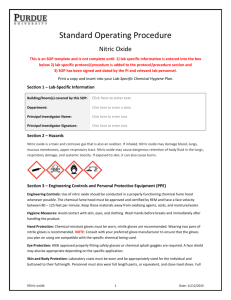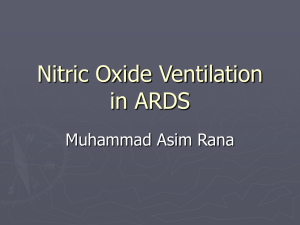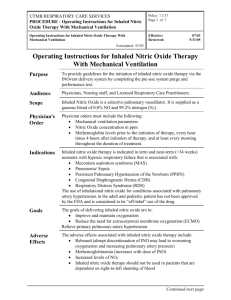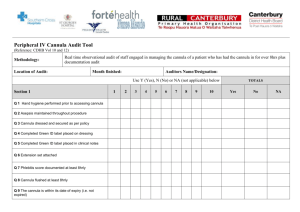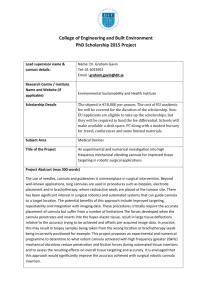Delivery of Inhaled Nitric Oxide Therapy Through an Adult or
advertisement
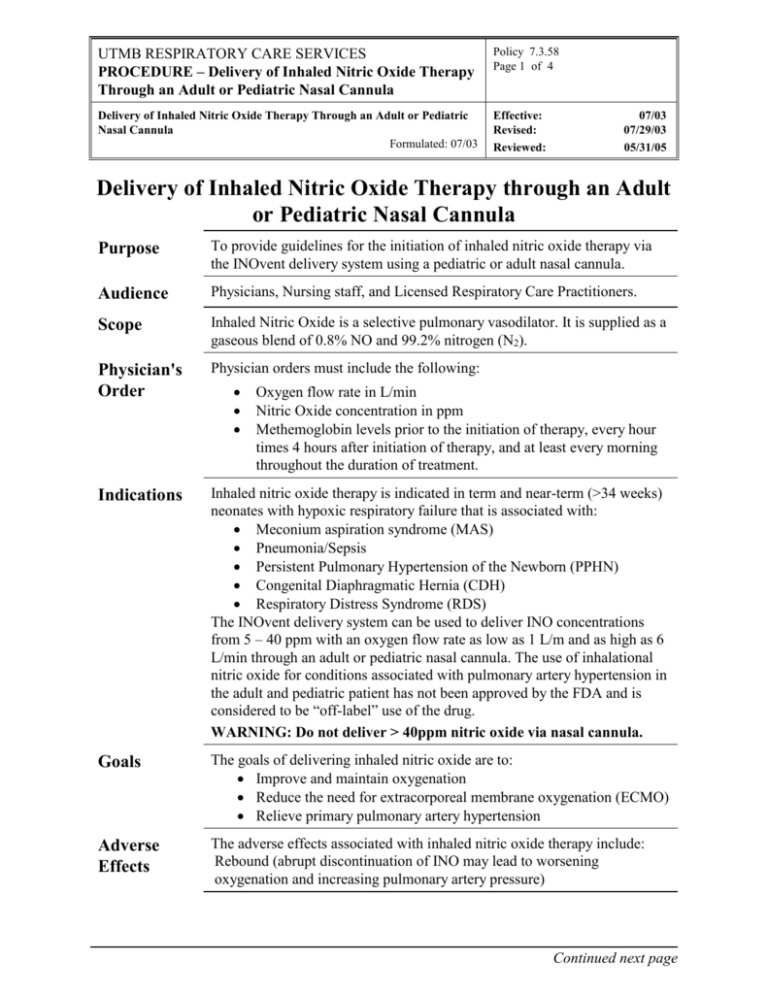
UTMB RESPIRATORY CARE SERVICES PROCEDURE – Delivery of Inhaled Nitric Oxide Therapy Through an Adult or Pediatric Nasal Cannula Policy 7.3.58 Page 1 of 4 Delivery of Inhaled Nitric Oxide Therapy Through an Adult or Pediatric Nasal Cannula Formulated: 07/03 Effective: Revised: Reviewed: 07/03 07/29/03 05/31/05 Delivery of Inhaled Nitric Oxide Therapy through an Adult or Pediatric Nasal Cannula Purpose To provide guidelines for the initiation of inhaled nitric oxide therapy via the INOvent delivery system using a pediatric or adult nasal cannula. Audience Physicians, Nursing staff, and Licensed Respiratory Care Practitioners. Scope Inhaled Nitric Oxide is a selective pulmonary vasodilator. It is supplied as a gaseous blend of 0.8% NO and 99.2% nitrogen (N2). Physician's Order Physician orders must include the following: Indications Inhaled nitric oxide therapy is indicated in term and near-term (>34 weeks) neonates with hypoxic respiratory failure that is associated with: Meconium aspiration syndrome (MAS) Pneumonia/Sepsis Persistent Pulmonary Hypertension of the Newborn (PPHN) Congenital Diaphragmatic Hernia (CDH) Respiratory Distress Syndrome (RDS) The INOvent delivery system can be used to deliver INO concentrations from 5 – 40 ppm with an oxygen flow rate as low as 1 L/m and as high as 6 L/min through an adult or pediatric nasal cannula. The use of inhalational nitric oxide for conditions associated with pulmonary artery hypertension in the adult and pediatric patient has not been approved by the FDA and is considered to be “off-label” use of the drug. WARNING: Do not deliver > 40ppm nitric oxide via nasal cannula. Goals The goals of delivering inhaled nitric oxide are to: Improve and maintain oxygenation Reduce the need for extracorporeal membrane oxygenation (ECMO) Relieve primary pulmonary artery hypertension Adverse Effects The adverse effects associated with inhaled nitric oxide therapy include: Rebound (abrupt discontinuation of INO may lead to worsening oxygenation and increasing pulmonary artery pressure) Oxygen flow rate in L/min Nitric Oxide concentration in ppm Methemoglobin levels prior to the initiation of therapy, every hour times 4 hours after initiation of therapy, and at least every morning throughout the duration of treatment. Continued next page UTMB RESPIRATORY CARE SERVICES PROCEDURE – Delivery of Inhaled Nitric Oxide Therapy Through an Adult or Pediatric Nasal Cannula Policy 7.3.58 Page 2 of 4 Delivery of Inhaled Nitric Oxide Therapy Through an Adult or Pediatric Nasal Cannula Formulated: 07/03 Effective: Revised: Reviewed: Adverse Effects Continued Equipment Procedure 07/03 07/29/03 05/31/05 Methemoglobinemia (increases with dose of INO) Increased levels of NO2 Inhaled nitric oxide therapy should not be used in patients that are dependent on right-to-left shunting of blood 1 - INOvent delivery system 2 - Full NO cylinders 1 - Adult or Pediatric nasal cannula 1 - Adult or Pediatric manual resuscitation bag Refer to the appropriate equipment manual for assembly instructions. Step Action 1 Perform pre-use system purge and performance test as outlined in Policy #7.3.62. 2 Assemble Injector Module for patient delivery of INO as outlined in the operations manual. See Appendix I. 3 Obtain arterial blood gas analysis of methemoglobin level prior to the initiation of therapy. 4 Set oxygen concentration in L/min at the wall flow meter. 5 After connecting the INOvent delivery system to the patient nasal cannula, push the Set NO button and turn the control wheel clockwise to increase the NO concentration or counterclockwise to decrease the concentration. Push either the Set NO button or the control wheel to confirm the set concentration. 6 WARNING: Increasing the NO setting will increase the NO flowrate, which may cause a bolus of NO2 to be delivered to the patient. If the NO setting is to be increased by more than 5 ppm within a 5-minute period of time, a quick purge of the INOvent should be performed. To perform quick purge, disconnect the cannula from sample tee and increase the oxygen flow to 15 L/m at the desired NO setting for 1 minute. When purge is complete, reduce the oxygen flow to desired setting and reconnect cannula to sample tee. Caution: An abrupt interruption of INO therapy may Continued next page UTMB RESPIRATORY CARE SERVICES PROCEDURE – Delivery of Inhaled Nitric Oxide Therapy Through an Adult or Pediatric Nasal Cannula Policy 7.3.58 Page 3 of 4 Delivery of Inhaled Nitric Oxide Therapy Through an Adult or Pediatric Nasal Cannula Formulated: 07/03 Effective: Revised: Reviewed: 07/03 07/29/03 05/31/05 Procedure Continued 5 Continued induce a rebound effect; it is recommended that if INO dosing needs to be increased, do so in 1-2 ppm increments to avoid bolus delivery of NO2. Assure that NO2 levels remain stable before further increases are made. 6 After the monitored values have stabilized, set or change the user-adjustable alarms to the appropriate ranges. O2 alarms should be set + 5% of desired FiO2 NO2 high alarm should be set at 3.0 ppm NO alarms should be set + 5 ppm of desired level 7 A low range calibration of sensors needs to be completed daily throughout the duration of therapy. Push the calibration button to reach the first Calibration menu. Highlight the Low Range (room air) NO, NO2, O2 option. Push the control wheel to start the low range calibration. All three sensors will calibrate automatically at the same time. 8 Connect manual NO delivery system as outlined in Policy 7.3.62 to ensure the ability to manually resuscitate a patient requiring INO therapy. 9 Methemoglobin levels should be drawn one hour after the initiation of therapy and checked q1 times four hours to monitor for increases in methemoglobin. Assessment of Outcome Infection Control Follow procedures as outlined Healthcare Epidemiology Policies and Procedures: #2.24 Respiratory Care Services. http://www.utmb.edu/policy/hcepidem/search/02-24.pdf Safety Precautions Oxygen safety techniques as outlined in section 3.6 of the INOvent Manual will be followed. Arterial, venous and capillary blood gas values Pulse oximetry Pulmonary artery pressures All alarms on INO delivery system will be on at all times. Continued next page UTMB RESPIRATORY CARE SERVICES PROCEDURE – Delivery of Inhaled Nitric Oxide Therapy Through an Adult or Pediatric Nasal Cannula Policy 7.3.58 Page 4 of 4 Delivery of Inhaled Nitric Oxide Therapy Through an Adult or Pediatric Nasal Cannula Formulated: 07/03 Effective: Revised: Reviewed: References 07/03 07/29/03 05/31/05 INOvent Delivery system In-Service guide and operations manual. Hess, Dean R. et al, Respiratory Care Principles and Practice, W.B. Saunders Company, St. Louis, 2002. Whitaker, K., Comprehensive Perinatal and Pediatric Respiratory Care, Delmar, Albany, New York, 2001. Tang SF, Miller OI. Inhaled nitric oxide during emergency neonatal transportation. J Paediatric Child Health. 1996; 32:539-541. Cornfield DN, Abman SH. Inhalational nitric oxide in pulmonary parenchymal and vascular disease. Journal of Laboratory Clinical Medicine 1996 Jun; 127(6): 530-539. Miller CL. Nitric oxide therapy for the persistent pulmonary hypertension of the newborn. Neonatal Network 1995 Dec; 14(8): 9-15. Angelucci P. A new weapon against ARDS…adult respiratory distress syndrome. RN 1996 Nov; 59(11): 22-25. Appendix I.
